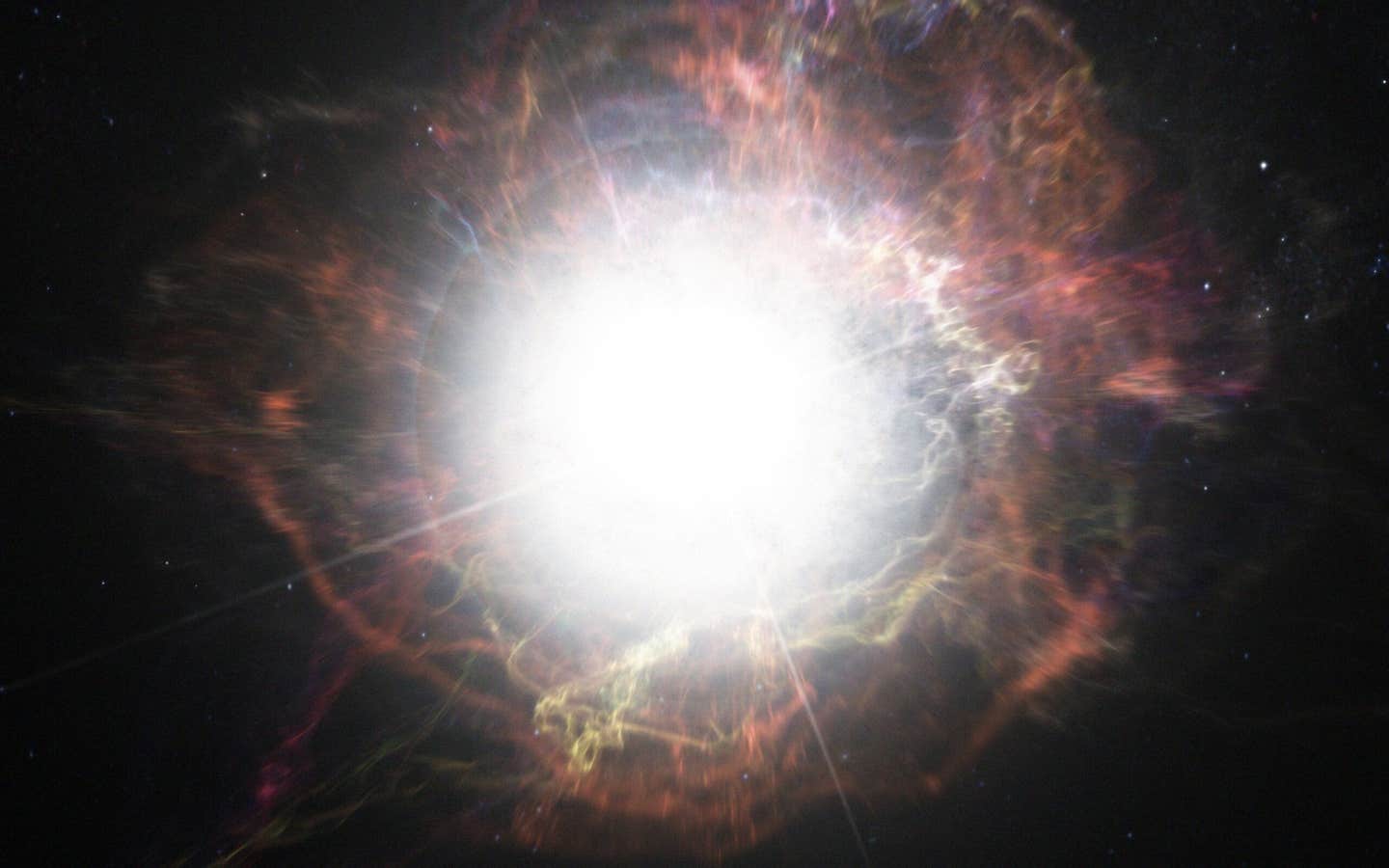First-ever radio waves observed from a white dwarf star supernova
For the first time, astronomers peered into the depths of the universe and witnessed the spectacle of radio waves emitted by a supernova.

[May 19, 2023: Staff Writer, The Brighter Side of News]
For the first time, astronomers have peered into the depths of the universe and witnessed the captivating spectacle of radio waves emitted by a Type Ia supernova. (CREDIT: ESO/M. Kornmesser)
For the first time, astronomers have peered into the depths of the universe and witnessed the captivating spectacle of radio waves emitted by a Type Ia supernova, shedding light on the enigmatic nature of these explosive events.
This groundbreaking discovery provides a glimmer of hope in unraveling the mysteries behind the cataclysmic demise of white dwarf stars and brings us closer to comprehending the intricate mechanisms of their explosions.
Type Ia supernovae, often referred to as "One-A" supernovae, represent the colossal nuclear eruptions of white dwarf stars. These celestial detonations hold immense significance in the field of astronomy as they serve as vital tools for measuring cosmological distances and gauging the expansion of our vast universe.
Despite their prominence, the precise mechanism that triggers Type Ia supernovae has long eluded scientists' grasp. The prevailing theory suggests that these white dwarfs rely on mass accretion from a neighboring companion star to initiate the explosive chain of events.
Related Stories:
It was hypothesized that the accumulated matter typically consists primarily of hydrogen, but the possibility of white dwarfs accreting helium from companion stars bereft of their hydrogen-rich outer layers was also postulated.
In the cosmic ballet between a white dwarf and its companion star, the former diligently strips matter from its stellar partner. However, not all of this material cascades onto the white dwarf's surface; instead, a fraction coalesces to form a nebulous shroud of circumstellar material enveloping the binary star system.
Scientists surmised that when a white dwarf detonates within this cocoon of circumstellar matter, the ensuing shockwaves would jolt atoms, prompting them to release intense radio waves. Curiously, while astronomers have observed numerous Type Ia supernovae erupting within circumstellar material, the radio wave emissions associated with these cosmic upheavals have eluded their scrutiny—until now.
Artist’s impression of helium-rich material from a companion star accreting onto a white dwarf. Before the explosion, a large amount of material is stripped from the companion. The research team hopes to clarify the relationship between the emitted strong radio waves and this stripped material. (CREDIT: Adam Makarenko/W. M. Keck Observatory)
In a remarkable collaborative effort, an international team of researchers, comprising esteemed members from Stockholm University and the National Astronomical Observatory of Japan, embarked on an audacious quest to decipher the secrets of a Type Ia supernova that burst forth in the year 2020.
Meticulously scrutinizing this celestial spectacle, the team made a revelation of profound significance. The supernova in question was ensconced within circumstellar material predominantly composed of helium. Moreover, their efforts bore fruit as they successfully detected the elusive radio waves emanating from this extraordinary event.
By comparing the strength of the observed radio waves with existing theoretical models, the researchers ascertained that the progenitor white dwarf star had been gradually amassing material at a rate equivalent to one-thousandth of the Sun's mass annually. This groundbreaking observation marked the first confirmed instance of a Type Ia supernova being triggered by the accretion of helium-rich material from a companion star.
The implications of this momentous discovery extend far beyond the realm of astrophysics. The observation of radio waves emanating from a helium-rich Type Ia supernova promises to deepen our understanding of the intricate explosion mechanisms and the conditions preceding these stellar cataclysms.
The position of the radio detection is consistent with the position of SN 2020eyj in the optical. The average position of the e-MERLIN detections (black circle, 0.01″ uncertainty), the position reported in GaiaAlerts (G band, green circle, 0.06″ uncertainty) and the position of SN 2020eyj in the ALFOSC epoch at 382 days (r band, red circle, 0.1″ uncertainty), overlaid on a 4″ × 4″ Pan-STARRS1 i-band dataset of the host. b, A 3′ × 3′ colour composite image, obtained with NOT/ALFOSC, of the compact star-forming host galaxy of SN 2020eyj and its environment. (CREDIT: Nature)
Armed with this newfound knowledge, the intrepid team of scientists now sets its sights on an ambitious endeavor—to scour the cosmos for radio emissions originating from other Type Ia supernovae.
By examining these radio wave signatures, they hope to unravel the complex evolutionary processes that culminate in these awe-inspiring cosmic detonations.
These results appeared as Kool et al. “A radio-detected Type Ia supernova with helium-rich circumstellar material” in the journal Nature.
Note: Materials provided above by The Brighter Side of News. Content may be edited for style and length.
Like these kind of feel good stories? Get the Brighter Side of News' newsletter.
Joseph Shavit
Head Science News Writer | Communicating Innovation & Discovery
Based in Los Angeles, Joseph Shavit is an accomplished science journalist, head science news writer and co-founder at The Brighter Side of News, where he translates cutting-edge discoveries into compelling stories for a broad audience. With a strong background spanning science, business, product management, media leadership, and entrepreneurship, Joseph brings a unique perspective to science communication. His expertise allows him to uncover the intersection of technological advancements and market potential, shedding light on how groundbreaking research evolves into transformative products and industries.



